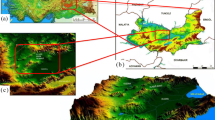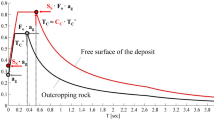Abstract
The Standard Penetration Test (SPT) is increasingly used to generate shear wave velocity (V S ) profile of a site for seismic hazard assessment. However, it is difficult to perform site investigation using the SPT for weathered rock and bedrock even at shallow depths in most cases. Consequently, the stiffness of bedrock (V Sb ) is assumed to be 760 m/s, and only partial thickness of weathered rock is used for site response assessment in Korea. The increase in V Sb and thickness of weathered rock (H w ) may affect the overall seismic response of a site, even though the site response is mostly governed by the upper soil layers. In this study, the effect of V Sb and H w on response spectrum in Korea was investigated by performing equivalent-linear site response analyses on three representative sites each of S C and S D soil categories as defined in the Korean seismic code based on the average shear wave velocity of top 30 m of a site (VS30). The S C and S D categories are defined similar to that in the International Building Code (IBC). Further, the effect of increase in VSb and Hw on the selection of design response spectrum based on seismic codes was also investigated. An increase in V Sb resulted in an increase in spectral amplification, while the effect of increase in Hw was not substantial for the representative sites considered in this study. This means that the V S of bedrock needs to be assessed properly. On the other hand, it is possible to get a reliable seismic response even if the Hw cannot be determined accurately. The incorporation of V Sb in V S30 for shallow bedrock sites (bedrock depth < 30 m) fails to consider the effect of increase in seismic amplification at large V Sb . Hence, it is preferable to consider the effect of V Sb separately on the design response spectrum. In addition, the effect on soil non-linearity due to variation in the V Sb and H w was found to be insignificant.
Similar content being viewed by others
References
Ansal, A., Durukal, E., and Tönük, G. (2006). “Selection and scaling of real acceleration time histories for site response analyses.” Proceedings of ETC12 Workshop, Athens, Greece, pp. 93–98.
Borcherdt, R. (1996). “Preliminary amplification estimates inferred from strong ground-motion recordings of the Northridge earthquake of January 17, 1994.” Proc. International Workshop on Site Response Subjected to Strong Earthquake Motions, Port and Harbor Research Institute, 2, pp. 21–46.
BSSC (1997). NEHRP Recommendation provisions for seismic regulations for new buildings and other structures: Part 1, Provisions, Building Seismic Safety Council, Washington, D.C.
CEN (2003). Eurocode-8: Design of structures for earthquake resistance, Part 1.1: General rules, seismic actions and rules for buildings, PrEN 1998-1. C. E. d. Normalisation, British Standard Institution, London.
Dobry, R., Borcherdt, R. D., Crouse, C. B., Idriss, I. M., Joyner, W.B., Martin, G. R., Power, M. S., Rinne, E. E., and Seed, R. B. (2000). “New site coefficients and site classification system used in recent building seismic code provisions.” Earthquake Spectra, Vol. 16, No. 1, pp. 41–67, DOI: 10.1193/1.1586082.
Dobry, R., Ramos, R., and Power, M. S. (1999). Site factors and site categories in seismic codes, Technical Report MCEER-99-0010, Multidisplinary Center for Earthquake Engineering Research, Buffalo, N.Y.
Gajer, R., Dobry, R., Silva, W., Thomann, T., Kishore, K., Patel, J., Razzaq, A., and Jain, S. (2008). 2008 New York City DOT Seismic design guidelines for bridges considering local site conditions, Sixth National Seismic Conference on Bridges and Highways, Charleston, South Carolina.
IBC (2012). International Building Code, International Code Council, Washington DC,United States.
Idriss, I. and J. I. Sun (1992). “User’s Manual for SHAKE91.” Center for Geotechnical Modeling, Department of Civil Engineering, University of California, Davis, C.A.
Jacob, K. H. (1991). “Seismic zonation and site response: Are building code soil-factors adequate to account for variability of site conditions across the US?.” Proceedings, 4th International Conference on Microzonation, Earthquake Engineering Research Institute, Stanford University, Palo Alto, California, Vol. 1, pp. 695–702.
Kim, D. S. and Choo, Y. W. (2001). “Deformation characteristics of hydraulic-filled cohesionless soils in Korea.” Proc. of the 4th International Conference on Recent Advances in Geotechnical Earthquake Engineering and Soil Dynamics, San Diego, CA.
Kim, D. S. and Yoon, J. K. (2006). “Development of new site classification system for the regions of shallow bedrock in Korea.” Journal of Earthquake Engineering, Vol. 10, No. 03, pp. 331–358, DOI: 10.1142/S1363246906002669.
KISTEC (2011). Guidelines for seismic performance evaluations of soils and foundations supporting existing structures, Korea Infrastructure Safety & Technology Corporation.
Kramer, S. L. (1996). Geotechnical earthquake engineering, Prentice Hall Upper Saddle River, New Jersey.
Lee, S.H., Sun, C. G., Yoon, J. K., and Kim, D. S. (2012). “Development and verification of a new site classification system and site coefficients for regions of shallow bedrock in Korea.” Journal of Earthquake Engineering, Vol. 16, No. 6, pp. 795–819, DOI: 10.1080/13632469.2012.65849116.
MOCT (1997). Korean seismic design standard, Ministry of Construction and Transportation, Seoul, Korea (in Korean).
PEER (2012). Pacific earthquake engineering research center ground motion database.
Seed, H. B. and Idriss, I. M. (1970). Soil moduli and damping factors for dynamic response analyses, Report No. EERC 70-10, Earthquake Engineering Research Center, University of California, Berkeley, CA.
Sun, C. G. (2014). “Earthquake engineering bedrock based on the shear wave velocities of rock strata in Korea.” The Journal of Engineering Geology, Vol. 24, No. 2, pp. 273–281, DOI: 10.9720/kseg.2014.2.273.
Sun, C. G. (2015). “Determination of mean shear wave velocity to 30m depth for site classification using shallow depth shear wave velocity profile in Korea.” Soil Dynamics and Earthquake Engineering, Vol. 73, pp. 17–28, DOI: 10.1016/j.soildyn.2015.02.011.
Sun, C. G., Cho, C. S., Son, M. K., Shin, J. S. (2013). “Correlations between shear wave velocity and in-situ penetration test results for Korean soil deposits.” Pure and Applied Geophysics, Vol. 170, No. 3, pp. 271–281, DOI: 10.1007/s00024-012-0516-2.
Sun, C. G., Han, J. T., and Cho, W. J. (2012). “Representative shear wave velocity of geotechnical layers by synthesizing in-situ seismic test data in Korea.” The Journal of Engineering Geology, Vol. 22, No. 3, pp. 293–307, DOI: 10.9720/kseg.2012.3.293.
Sun, C. G., Kim, D. S., and Chung, C. K. (2005). “Geologic site conditions and site coefficients for estimating earthquake ground motions in the inland areas of Korea.” Engineering Geology, Vol. 81, No. 4, pp. 446–469, DOI: 10.1016/j.enggeo.2005.08.002.
Vucetic, M. and R. Dobry (1991). “Effect of soil plasticity on cyclic response.” Journal of Geotechnical Engineering, Vol. 117, No. 1, pp. 89–107, DOI: 10.1061/(ASCE)0733-9410(1991)117:1(89).
Wair, B., Dejong J. T., and Shantz, T. (2012). Guidelines for estimation of shear wave velocity profiles, Pacific Earthquake Engineering Research Center, PEER Report 8.
Author information
Authors and Affiliations
Corresponding author
Additional information
An erratum to this article is available at http://dx.doi.org/10.1007/s12205-016-1811-8.
Rights and permissions
About this article
Cite this article
Manandhar, S., Cho, H.I. & Kim, D.S. Effect of bedrock stiffness and thickness of weathered rock on response spectrum in Korea. KSCE J Civ Eng 20, 2677–2691 (2016). https://doi.org/10.1007/s12205-016-0811-z
Received:
Revised:
Accepted:
Published:
Issue Date:
DOI: https://doi.org/10.1007/s12205-016-0811-z




